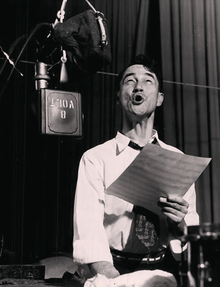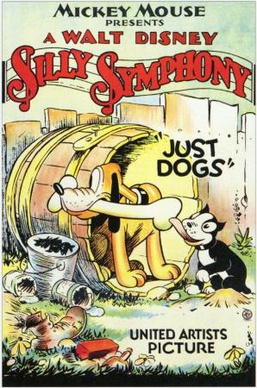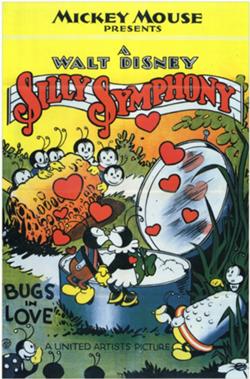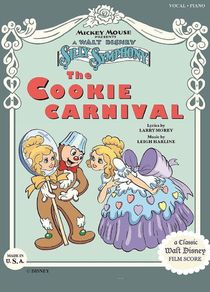
The Wise Little Hen is a 1934 Walt Disney's Silly Symphony cartoon, based on the fable The Little Red Hen. The cartoon features the debut of Donald Duck, dancing to "The Sailor's Hornpipe". Donald and his friend Peter Pig try to avoid work by faking stomach aches until Mrs. Hen teaches them the value of labor.

Vance DeBar Colvig Sr., known professionally as Pinto Colvig, was an American voice actor, cartoonist, and circus and vaudeville performer whose schtick was playing the clarinet off-key while mugging. Colvig was the original performer of the Disney characters Goofy and Pluto, as well as Bozo the Clown. In 1993, he was posthumously made a Disney Legend for his contributions to Walt Disney Films, including Snow White and the Seven Dwarfs and Fun and Fancy Free.

Babes in the Woods is a 1932 Silly Symphonies animated film.

Three Little Pigs is a 1933 animated short film released by United Artists, produced by Walt Disney and directed by Burt Gillett. Based on the fable of the same name, the Silly Symphony won the 1934 Academy Award for Best Animated Short Film. The short cost $22,000 and grossed $250,000.

Three Little Wolves is a Silly Symphony cartoon. Released on April 18, 1936, and directed by Dave Hand. It was the third Silly Symphony cartoon starring the Three Little Pigs. It is loosely based on The Boy Who Cried Wolf. It introduces the Big Bad Wolf's sons, the Three Little Wolves, all of them just as eager for a taste of the pigs as their father.
Elmer Elephant is a Silly Symphony cartoon short produced by The Walt Disney Company, directed by Wilfred Jackson and released on March 28, 1936.
Music Land is a Silly Symphony animated Disney short released in 1935.

The Big Bad Wolf is an animated short released on April 13, 1934, by United Artists, produced by Walt Disney and directed by Burt Gillett as part of the Silly Symphony series. Acting partly as a sequel to the wildly successful adaptation of The Three Little Pigs of the previous year, this film also acts as an adaptation of the fairy-tale Little Red Riding Hood, with the Big Bad Wolf from 1933's Three Little Pigs acting as the adversary to Little Red Riding Hood and her grandmother.

The Tortoise and the Hare is an American animated short film part of the Silly Symphony series, released on January 5, 1935, by United Artists, produced by Walt Disney and directed by Wilfred Jackson. Based on an Aesop's fable of the same name, it won the 1934 Oscar for Best Short Subject: Cartoons. This cartoon is also believed to be one of the inspirations for Bugs Bunny by Warner Bros., who first appeared in 1940.

King Neptune is a 1932 cartoon by Walt Disney, the second in the Silly Symphonies series produced in Technicolor. While Flowers and Trees was originally intended as a black and white cartoon, King Neptune was meant to be in colors already from the start, and was able to take full advantage of this.

Old King Cole is a Disney cartoon in the Silly Symphonies series, based on several nursery rhymes and fairy tales, including Old King Cole. It was directed by David Hand and released on July 29, 1933.

The Grasshopper and the Ants is a 1934 American animated short film produced by Walt Disney Productions and released by United Artists. Part of the Silly Symphonies series, the film is an adaptation of The Ant and the Grasshopper, one of Aesop's Fables. It was directed by Wilfred Jackson and stars Pinto Colvig as the voice of the grasshopper Hop.
Mother Pluto is a Silly Symphonies cartoon released on November 14, 1936, directed by Wilfred Jackson. The cartoon features Pluto.

Three Blind Mouseketeers is a Silly Symphonies cartoon based on the nursery rhyme Three Blind Mice and the 1844 novel The Three Musketeers by Alexandre Dumas. Directed by Dave Hand and Jack Cutting, it stars Billy Bletcher.

Wynken, Blynken & Nod is a 1938 Silly Symphonies cartoon, adapted from Eugene Field's poem of the same name. Like other Symphonies at the time, it utilized the multiplane camera. It was directed by Graham Heid, produced by Walt Disney Productions, and distributed by RKO Radio Pictures. The three children bore similarities to Michael Darling in the 1953 Disney feature film, Peter Pan.
Mother Goose Melodies is a 1931 Silly Symphonies animated film, directed by Burt Gillett. Two years later it was semi remade in Technicolor as Old King Cole.

Just Dogs is a 1932 animated film part of the Silly Symphony series, directed by Burt Gillett. It marked the first solo appearance of Pluto.

Bugs in Love is a Silly Symphonies animated Disney short film. It was released in 1932, and was the final Symphony to be shot with black-and-white film.

The Goddess of Spring is a 9-minute Silly Symphonies animated Disney short film. The Symphony is imbued with operatic themes and is often cited as melodramatic. It was released in 1934, and its production was important to the future development of Disney's Snow White and the Seven Dwarfs animation. Each Silly Symphony was a technological marvel at the time and proceeded to further advancements in the animation industry.
Silly Symphony, initially titled Silly Symphonies, was a weekly Disney comic strip that debuted on January 10, 1932, as a topper for the Mickey Mouse strip's Sunday page. The strip featured adaptations of Walt Disney's popular short film series, Silly Symphony, which released 75 cartoons from 1929 to 1939, as well as other cartoons and animated films. The comic strip outlived its parent series by six years, ending on October 7, 1945.















